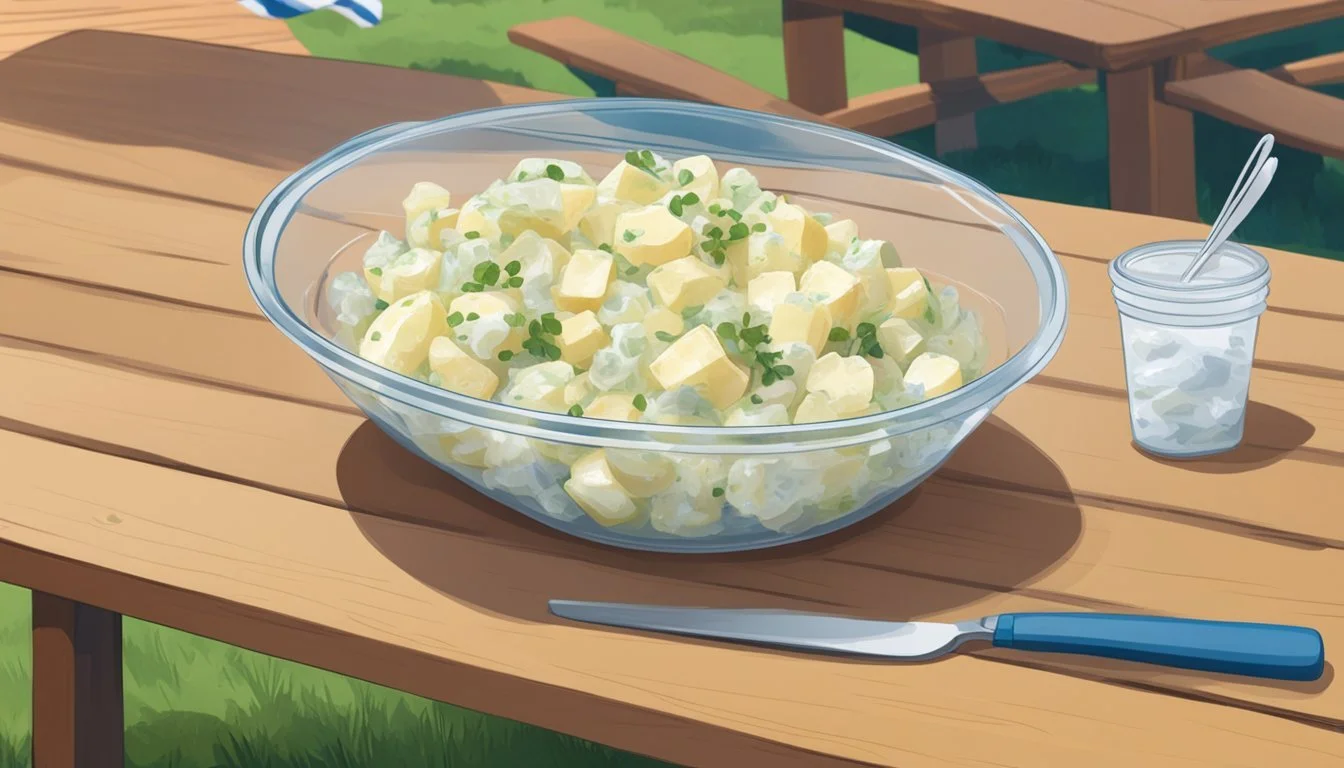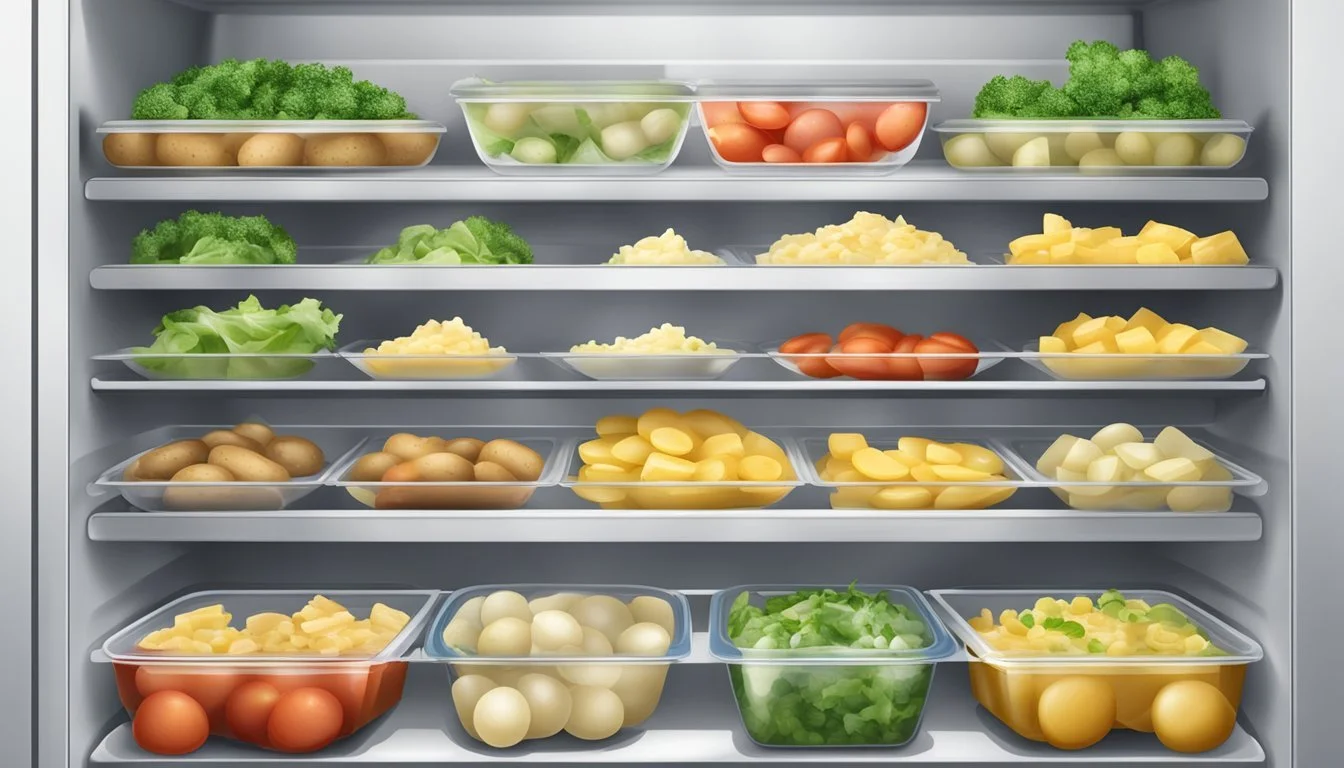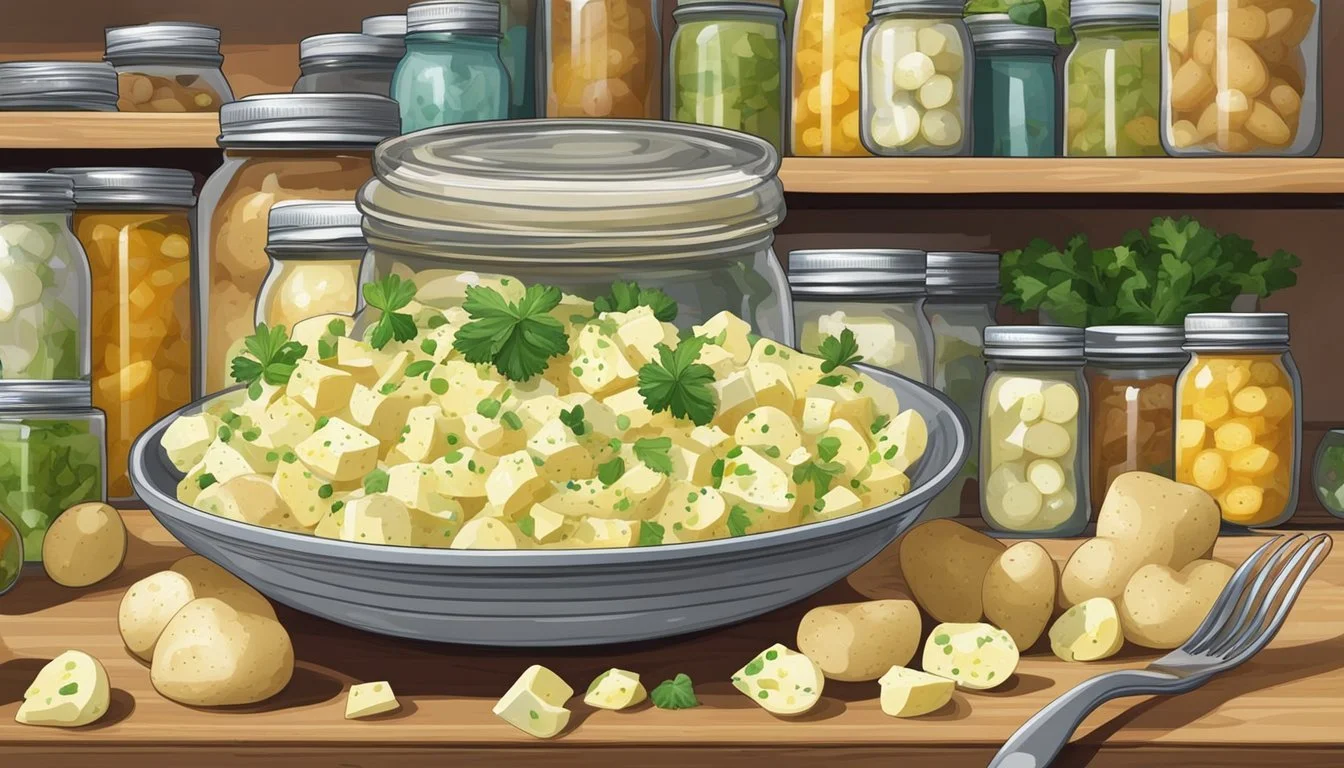How Long Does Freshly Prepared Potato Salad Last?
Shelf Life Explained
When it comes to freshly prepared potato salad, its longevity in the fridge is a common concern among both home cooks and food enthusiasts. The shelf life of this favorite side dish is influenced by several factors, including the freshness of the ingredients used, the temperature at which it is stored, and how quickly it was refrigerated after being made. Typically, a freshly prepared potato salad will maintain its quality for 3-5 days when stored correctly in the refrigerator at or below 40°F.
Proper storage is critical to extending the life of potato salad and keeping it safe to eat. It should be kept in an airtight container to prevent contamination and absorption of other food odors in the fridge. It’s also important to ensure that the potato salad is not left out at room temperature for extended periods, as bacteria can grow rapidly between the temperatures of 40°F and 140°F. If the salad has been left out for more than two hours, the risk of bacterial growth increases, and it should be discarded.
Freshness is another key component affecting the lifespan of potato salad in the fridge. Fresh, high-quality ingredients can help maximize the duration for which the salad remains good to eat. However, even with optimal storage and fresh ingredients, consumers should use their senses to evaluate the potato salad before consuming it. If it exhibits any off smells, has an abnormal appearance, or there is any doubt about its safety, it should not be consumed.
Understanding Potato Salad
Potato salad is a classic dish that combines cooked potatoes with an array of ingredients to create a rich and flavorful side. It can be served warm or chilled, and is a staple at many gatherings.
Key Ingredients
Potato salad primarily consists of:
Potatoes: The base of the salad, typically peeled and cubed.
Mayonnaise or dressing: To provide a creamy texture.
Eggs: Often hard-boiled and diced for added protein.
Mustard: Used to give a tangy flavor.
Vinegar: Adds a touch of acidity.
Onions and celery: For crunch and flavor.
Herbs and spices: Such as dill, salt, and pepper, to enhance the taste.
Common Recipes
The standard American potato salad recipe would include:
Boiling and cubing potatoes.
Mixing in mayonnaise, mustard, and vinegar.
Adding in diced onions, celery, and hard-boiled eggs.
Seasoning with salt, pepper, and other preferred herbs and spices.
Variations of Potato Salad
There are several popular variations of potato salad, some of which might include:
German potato salad: Typically served warm and made with a vinegar-based dressing and bacon.
Southern potato salad: It often contains mustard and mayonnaise, with a focus on a creamier texture.
Healthy potato salad: May substitute mayonnaise for Greek yogurt or use lighter dressings.
Cultural variations: Adjustments in ingredients and preparation methods can reflect different cultural tastes and preferences.
Storing Potato Salad
Proper storage is crucial for maintaining the freshness and safety of potato salad. By understanding and implementing ideal storage conditions, the role of temperature in preservation, and best practices for refrigeration, the shelf life of potato salad can be maximized.
Ideal Storage Conditions
Potato salad should be placed in an airtight container to prevent contamination from other foods and minimize exposure to air, which can accelerate spoilage. A container with a tight seal is also effective in retaining moisture and preventing the salad from absorbing any odors present in the fridge.
Temperature's Role in Preservation
Maintaining a consistent temperature is vital for the longevity of potato salad. The temperature range in which food-borne bacteria can rapidly multiply is between 40°F and 140°F. Therefore, it's important to keep potato salad refrigerated at a temperature below 40°F to hinder bacterial growth and maintain food safety.
Refrigeration Best Practices
When storing potato salad in the fridge, adhere to the following guidelines:
Cool Down: Allow the potato salad to reach room temperature before refrigerating to prevent raising the fridge's internal temperature.
Shallow Dish: Transfer the salad to a shallow dish to ensure more even cooling.
Storage Time: Refrigerated potato salad typically retains its quality for 3 to 5 days.
Consistent Temperature: Keep your fridge at a constant temperature to prevent fluctuations that could shorten the salad's shelf life.
By observing these storage recommendations, one can ensure that their potato salad remains both delicious and safe to consume for as long as possible.
Food Safety Considerations
Freshly prepared potato salad is susceptible to bacterial growth and spoilage if not handled properly. Understanding the risks and identifying when potato salad is no longer safe to consume is crucial for preventing foodborne illnesses.
Risk of Foodborne Illnesses
Potato salad, like many perishable items, can become a breeding ground for bacteria when left in the temperature range of 40°F to 140°F, commonly referred to as the danger zone. The presence of ingredients like mayonnaise can increase the risk of spoilage, particularly if the salad remains at room temperature for more than two hours. Bacteria such as Salmonella and Listeria can rapidly multiply in these conditions, leading to the potential for food poisoning.
Key Temperatures to Remember:
Below 40°F (4°C): refrigeration temperature to inhibit bacterial growth.
Above 140°F (60°C): temperatures at which hot foods should be maintained to prevent bacterial growth.
Recognizing Spoilage Signs
Identifying whether potato salad has gone bad is essential:
Sight: Look for any signs of mold or discoloration. These are clear indicators that the food is no longer safe to eat.
Smell: If the potato salad emits a sour or off odor, it's a sign that spoilage has occurred.
Texture: A slimy texture can indicate bacterial growth and spoilage.
Preventing cross-contamination during preparation and storage is also important; separate utensils and containers should be used for raw and cooked foods to minimize the risk.
Spoilage Signs Checklist:
Mold presence.
Discoloration.
Off or sour smell.
Slimy texture.
By adhering to food safety practices, one can minimize the risk of foodborne illness and ensure that potato salad remains a safe and enjoyable dish.
Shelf Life of Potato Salad
The shelf life of potato salad is typically between 3 to 5 days when stored properly in the refrigerator, with the variation in time largely depending on whether it's homemade or store-bought, as well as the specific ingredients used.
Homemade vs Store-Bought
Homemade potato salad, when kept in a fridge at a consistent and safe temperature, can last for 3 to 5 days. It is important to store the salad in airtight containers to preserve freshness. On the other hand, store-bought potato salad should be consumed by the expiration date on the package. Although these salads (What wine goes well with salads?) often contain preservatives that can extend their shelf life, one should always adhere to the labeled expiration date for safety.
Impact of Ingredients on Freshness
The ingredients used in potato salad greatly affect its longevity. Salads with dairy-based ingredients like mayonnaise are more prone to spoilage and typically adhere to the 3 to 5-day rule as dairy products can go bad quickly. Additionally, the presence of preservatives in store-bought potato salad can slightly prolong its freshness beyond homemade versions lacking these additives. Here is a brief breakdown:
Dairy-based homemade potato salad: Lasts for 3 to 5 days if refrigerated immediately after preparation.
Preservative-laden store-bought potato salad: Check expiration date, but generally safe to consume within 3 to 5 days of opening, if kept refrigerated.
Extending Shelf Life
Proper storage methods can significantly impact the longevity of freshly prepared potato salad. One such method is freezing, which can preserve the salad for future consumption.
The Freezing Option
Can you freeze potato salad? Yes, one can freeze potato salad, although this may affect its texture. It's important to note that potato salads with mayonnaise or creamy dressings might not freeze as well because these dressings can separate and become grainy when thawed.
Place the potato salad in airtight containers or heavy-duty freezer bags.
Label with the current date to keep track of how long the salad has been stored.
Thaw the potato salad in the refrigerator, allowing it to defrost slowly.
Stir the salad after thawing to reincorporate any separated dressing.
The texture of ingredients like potatoes and eggs may change slightly after freezing and thawing, making them softer than before. It is paramount to consume thawed potato salad within a day or two for optimal quality.
Serving and Consumption
When it comes to freshly prepared potato salad, proper serving and storage are crucial for maintaining its freshness and preventing foodborne illness. From the moment it's taken out from the fridge until it's served at various events, the temperature plays a vital role in its longevity.
From Fridge to Table
Upon removing potato salad from the refrigerator, one should serve it immediately. The salad should remain at a temperature under 40°F until ready to consume. If serving at an indoor event, the potato salad can be placed directly on the serving table. However, for outdoor gatherings like picnics or barbecues, it is recommended to keep the potato salad over ice or in a cooler to maintain its cold temperature, especially during warm weather.
Key highlights for serving potato salad:
Serve immediately after removing from the fridge
Keep below 40°F to maintain freshness and safety
Use ice or cooler for outdoor events to retain cold temperature
Longevity During Events
At events such as cookouts and potlucks, potato salad should not sit out at room temperature for more than two hours. In hotter conditions, above 90°F, this time reduces to just one hour. To ensure the salad remains safe and enjoyable, it should be kept cold, either on ice or in a cooler, and leftovers should be refrigerated promptly after the event.
Strategies for maintaining potato salad at events:
Do not leave at room temperature for more than two hours
In temperatures above 90°F, limit exposure to one hour
Store leftovers in refrigeration as soon as possible
By adhering to these precautions, one can ensure that potato salad remains both a delicious and safe side dish option at various gatherings.
Frequently Asked Questions
How long does freshly prepared potato salad last in the fridge?
Potato salad typically lasts 3-5 days when stored in the refrigerator at a temperature below 40°F. Proper refrigeration is essential for safety and to minimize the growth of bacteria.
Does the type of dressing used affect the shelf life of potato salad?
Yes, the ingredients can influence shelf life. Salad made with mayo, sour cream, or yogurt should adhere strictly to the 3-5 days rule. Dishes with a vinegar or vinaigrette base and high acid content may last slightly longer due to vinegar's preservative effects.
What is the temperature danger zone for potato salad?
The danger zone as defined by the USDA is between 40°F and 140°F. Potato salad should not be left out at room temperature for more than two hours, or one hour if the temperature is above 90°F, such as during family gatherings or summer events like the Fourth of July.
How can I ensure my potato salad stays fresh?
Store in an airtight container.
Use clean utensils when serving to avoid cross-contamination.
Ingredients like celery, green onions, and garlic should be fresh to extend shelf life.
Seasoning with salt not only adds flavor but also acts as a preservative.
Are there any signs that potato salad has gone bad?
Yes. Look out for:
Off-putting sour smell.
Discoloration or mold.
Slimy texture on the vegetables.
Separation of dressing. If any of these signs are present, it is best to discard the salad to prevent health risks.








